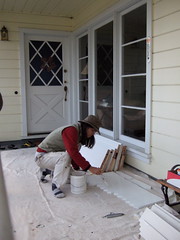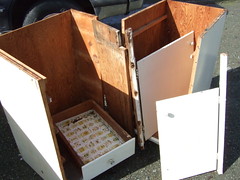The Lost Art of Bodging
A flickr contact knowledgeable about tools introduced me to the term "bodging" when I posted a picture of myself in my ad hoc workshop on our front porch. Bodging, I was to learn, describes the act of creating things from a mish mash of available materials in a makeshift workshop. Derived from the term to bodge which specifically refers to the turning of tree branches into chair legs using a foot operated lathe.
I was thrilled with the term. Thrilled that there was even a word to describe the kind of improvisational construction that I was doing, using discarded building materials, in an onsite workshop. My flickr friend directed me to another flickr member who had posted a picture of himself in a traditional bodging workshop he had created. He, himself, was the last known chair bodger in England and had even met the Queen, presenting her with a miniature Windsor chair.
In its original use, the term implied a host of other conditions, frowned upon by society, including itinerant workers and nomadic people. Nomadic workers interfered with the move towards privatization, for unclaimed land was needed to accommodate such workers. If locals valued their traveling tinker, tailor and bodger, then they would also value retaining a commons, an area of pasture land or a wooded lot, for parking a caravan and where materials could be harvested to support the livelihood of the traveler while serving the needs of the locals. Moneyed interests favoring privatization and industrialized goods won that battle I would say.
Such free materials as a bodger might use, today, can be found in the form of recyclables left on the curb and the rapidly disappearing "big trash" day. To observe the squabbles over who owns trash and recyclables once left on the curb is to note our societies ambivalence towards providing poor people with something for free. (I've had neighbors point out that I was not allowed to lift so much as a cereal box from another neighbor's recycle bin and in Oakland fines are in order.) For those who are Internet enabled, we have a virtual commons known as "Freecycle" on which to host the giving away of materials. And for a little money, e-Bay and Craigslist will provide.
What attracted me most to the whole concept of bodging was the creativity of it. With its lowered expectations of make do-ness, hobbled together discarded parts and make-it-work utilitarian improvisation, the term freed me. Bodging was function derived, plain speaking and simple. But best of all it made use of discarded materials, something a throwaway society had in excess. I picked materials, much as an artist would, attracted by texture, line and form, but also because of its durability, strength and that it just happened to be there.
The Serendipity of Small Things
Late last year a new client asked me, during the obligatory tour of the house, if I knew anyone who would take away the six closet doors she could no longer use that were now stacked outside against the fence. She had not been able to give them away even on Freecycle. That same week I got a call requesting an organizer who installed green closets.
What passes for green closets in this world of prefab installations are the same manufactured melamine covered particle board closets seen in the slick ads, but made with "green" particle board. This means they are formaldehyde free and made from recycled wood fiber or even straw, but still using copious amounts of energy in the manufacturing process. Add to that transportation costs and a higher price for the premium of being green. Such "green" particle board is not available to me at local lumberyards. Was during a Green phase, but no more.
Would such an enlightened eco client accept the use of reclaimed materials if nicely painted with leftover low emission paint? I measured, I drew pictures and layouts, I calculated my time and delivered a bid. The client accepted the proposal, happily, as if discovering a find (plus a closet company would have charged more). The client, with the doors, gladly let me strap them to the roof of my car.
The goddess of small, serendipitous occurrences seems eager to make such matches for me, helping everyone in the process. The week I accepted my first project with doors, I found all I needed from Criag's list plus extra I didn't know I would need. And when the client asked for drawers I found an old desk on Freecycle with exactly the number of drawers I needed. Recently, while cycling to Karate class, the plywood in old bathroom cabinets, discarded on the sidewalk, attracted my eye, a light rain having brought out the patterns of woodgrain. I picked them up the following morning and spent that afternoon building myself a rolling caddy to house my collection of scrap wood, my workshop now looking less hovel-like as a result.
I suspect that this serendipity, on a small community level scale, is a part of the bodging experience. It does not seem to work if I don't really mean it. I cannot, for instance duplicate the availability of materials if I search, during idle moments, online, with no project needing to be built.
The Freedom To Fail
While talking up my trash transforming ways, a fellow green organizer recommended the movie Garbage Warrior. Michael Reynolds, a modern day bodger, extreme recycler and builder of houses from trash, got his start in the '70s in the middle of the New Mexico dessert. He invented the earthship with its earth filled, automobile tires for walls, creating a climate controlled interior without using any outside energy inputs at all. The houses also collected rainwater and recycled wash water into an indoor garden that produced food, even bananas, while outside it was snowing.
Such a miracle of innovation did not come easily, for mistakes were made and lawsuits were filed. And soon the controlling authorities came by to enforce regulations. These regulations disallowed such notions as humans living together in community without subdivisions and roads. Building codes forbid construction that is not foolproof. The result is an inflexible, one size fits all housing option. Such housing often did not fit the land or the humans occupying it let alone allow for innovation.
"I was not allowed to fail," Michael Reynods says poignantly. It was a statement of an artist, of the needs of one who creates.
Michael Reynolds, who had been trained as an architect, commented early in the film that everything he had learned for his training was worthless. He spoke of civilization heading for a precipice in terms of resource depletion and architects having missed the opportunity to change that direction. Traditional architecture was tied to centralized systems that made humans dependent on an outside source for water, electricity, food and building materials.
It was not in the spirit of bodging to be dictated to by a centralized system. To bodge is by definition to be independent, but also connected to local community and local resources, to interact with the availability of these resources and create something needed by members of the community. This requires experimentation and testing.
Had Steve Jobs not been born in Mountain View, where he was able as a teen, to rummage through discarded Hewlett Packard computer parts sold at community college flea markets and take them home to tinker with in his bedroom, we probably would not have the personal computer today (which then led to the decentralization of knowledge through the Internet creating a high-tech commons).
The IBMs of the world are slow to innovate having already invested so much in a particular vision. Likewise manufactures of materials want people to continue to use their product. Take plywood. When I was growing up, every plan I found in a magazine or book, showing a wood building project, required the use of 3/4" plywood. I built a portfolio cabinet from such a plan. When I was finished my engineer father asked if I had built a platform for an elephant. It was so heavy it only survived one move before I gave it away.
Later my father learned the cabinetmakers skill of building a lightweight frame over which was glued thin sheets of wood. I recognized this construction in hollow core doors and realized that half the work was done for me and thus my do-it-with-doors construction was born.
The Education of a Bodger:
Being a mish mash of skills and learning
When I was enrolled in a two semester Construction Technology course, nine years ago, I was struck by how different my life would have been had I taken this class when I was 18. The act of building was enormously energizing. The use of tools empowering. The hammering and buzz of a crew working together created an uncomplicated community. My success, I was sure, would have been manifested in property ownership and rental income. But then what were the chances that I would have escaped the indoctrination of building codes and stamped out suburban housing? Not to mention the gender discrimination at large, in the trades at the time, that probably would have propelled me into another field.
My bodging education had come largely from browsing shelves at the library during the '70s where I found the books of the counterculture and learned how to make my own clothes, build knock-down nomadic furniture, live on gorp and survive adulthood. I also picked up the attitudes, relayed by those authors, that making your own stuff was more than just saving a buck. It was about independence from a system that converted people to consumers and exploited group identities to sell, to us, the homogonous products of a manufactured world, robbing our minds of creativity in the process and making us slaves to a 9-5 job so we could afford to buy such things in the first place.
My home country still had local street side craftspeople when I was growing up. They fixed the flat tire on my bike, made shoes, welded gates, lived in makeshift housing, collected scrap and recycled everything, allowing me to see how it was done. When we moved to the U.S., my father's tools and woodpile, my mother's sewing machine and box of fabrics, plus the art supplies and craft kits they gave me, along with the unstructured time to use what I found, provided me with ample learning space.
I was also steered away from professions where the closet door was tightly shut. Like many LGBT people, this drew me to the arts, but not to writing. Fiction seemed to exclude my own story and research papers excluded my own culture, thus compelling me to find a degree that didn't require any writing at all—graphic design. Here was a field of idea-making that allowed me to think conceptually. It was also one of the last fields, before the onset of the computer, that still required the use of hand tools and drafting with a pencil on graph paper.
Thus armed with an exacto knife and technical drawings skills, I designed and built my first flat-pack, slot-together, storage unit out of foamcore to organize my desk.
The Hundredth Monkey
Such an education did not suit me to corporate work. The ten years I spent in an office environment squelched my brain and rendered me in a constant state of rebellion. The bodger is at heart an entrepreneur and it is in the arena of entrepreneurs that failure is a right of passage, improvisation a necessity and storytelling a motivational force, creating, for me, a mythology. I traveled the hero's journey in which I could make a difference as well as a living.
The famous story of the hundredth monkey, based on a study of monkeys on an island in Japan, concludes that once a critical mass of a society has taken on a new habit, such as washing fruit before eating it, that innovation is transferred to the entire species in a form of telepathic evolution. This story captured the imagination of motivational speakers and new agers hoping for a harmonic convergence. Later the popular story was debunked as it was found that the monkeys could swim and some had traveled to other islands. They were nomadic.
Nomadic peoples, it turns out are essential to society. The modern urban bodger, working the art of transforming trash into something useful, carries the idea of sustainability. Likewise professional organizers and other consultants bring innovation into the homes of those in need of solutions. Thus as we travel, from house to house, we become the hundredth monkey, the seed of innovation.
Labels: eco-living, innovation, livelihood, natural building, sustainability, tools







14 Comments:
Amanda, that is amazing.
I am an ex-Industrial arts teacher come bodger.
Your story so mirrors elements of my journeyyou might enjoy visiting my site, just 5 months old,
bodgershovel.com
it's a 'red-pill site really for the coming/unfolding collapse, as I have watched it for 3 years. A compendium of writings, and advice on slipping through the cracks...
I will browse your site.
Many thanks
Geoff
Hello Amanda,
Enjoyed your article on being a bodger. I lived in Uk for a long time and bodging was part of my life.
It's a common term used and understood by much of the population. However the term bodger applies to the person. The action is called bodging - to bodge something or to do a bodge-job - all very popular terms.
Keep on bodging, Cheers, Terry.
toliver36@hotmail.com
Geoff, I came across your site as I was researching this piece and was intrigued that a few others in peak oil community had already adopted the term so was encouraged to give it more exposure.
Terry, I am chagrined that I was using the term improperly. Thank-you for the correction. I shall have to backtrack and correct.
Yep, 'bodging' is the verb used in the UK.
Yes, academics complain that we bloggers have not the benefit of editorial assistance from on high, those so educated to protect the public from incorrect reporting. Thus we free range writers should not be trusted for public consumption, but here we have a splendid example of fact checking and correction from ones peers in this publishing commons. On Dasher, on Dancer, on Blogger and Bodger.
Bodging it is, not bodgering. I need to get back to the UK for a tune-up. Now if I could just get the term installed in spell check.
Hi - ran across this site by accident and had to post. I am a huge fan of the show ScrapHeap Challenge which I am sure you have heard of as it is the bodger's show.
Teams compete to bodge together such things as mini throwing trebuchets and jet powered dragsters out of scrap.
If you have not heard of it please get the DVD as it is the best show on television next to Mythbusters.
http://www.channel4.com/science/microsites/S/scrapheap2008/index.html
That's amazing Ender. I have not heard of this bodging show at all, not having seen British TV in a couple of decades. And they even use the word. I will defo have a look. Thanks for the link.
Amanda, your post reminds me of this innovative environmental education program at NorCal Waste (SF Recycling). The Artist-in-Residence is a coveted position among the artist community - getting to dig through the trash!
http://www.sunsetscavenger.com/AIR/index.php?t=d
YOu might want to rethink the IBM as the antithesis of innovate metaphor, it is out of date. Google IBM and photovoltaics or water cooled chips.
Hello Amanda,
When I was a renter, I couldn't wait to get my own home so I could start bodging (a term I learned just now from you). I had forgotten what my goal was while I was trying to "get ahead" in the corporate world, working 60 hours per week from dark to dark.
Now that I have a more flexible day job that leaves me with plenty of physical energy at the end of the day, I've rediscovered my yard and my garage, filled with all kinds of cool stuff I've been collecting over the years, just in case.
One thing I've like to bodge is my Prius into a plug-in, as decribed in your post from 2006. In that post you mentioned working with an EV enthusiast from up here in the Seattle area. I didn't recall seeing a name in your post, and I'm not sure which club, so if you could send me the contact info for that fellow, I'd be much appreciative.
Thank you!
Michael E
well
spring
marketing
@
live
.
com
Michael E. here is a picture of the owner and others plus names. I think he was part of the Seattle EV chapter.
Anonymous I think IBM may be stuck with that famous association for missing the PC boat, but I won't use the metaphor again, now that you've brought it to my attention.
Ooh! Ooh!
Amanda, I followed the link to flikr and got the names, thank you.
I also took a look at your slide show and I'd really, really like to find plans for the pedal-powered swing thing called the "Chupacabra". I'm looking ofr that now, too.
This seems interesting:
http://www.yellowtreehouse.co.nz/#/See-How-It-Happened/
Hi Amanda,
I like your article, it gives a great overview of the creativity of a great bodger. Ive set up a blog which ive bodge together which you might like to have a read of in the future.
http://theartofbodging.blogspot.com/
Post a Comment
<< Home